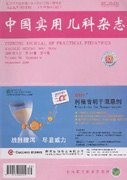|
Clinical features of epileptic encephalopathy caused by CASK gene variants
CHEN Yi,YANG Ying,NIU Xue-yang,et al
2021, 36(4):
275-280.
DOI: 10.19538/j.ek2021040608
Objective To analyze the genotype and phenotype features of children with CASK gene variants. Methods The clinical data of 4 epilepsy patients with CASK gene variants were retrospectively collected at the Pediatric Department of Peking University First Hospital from September 2016 to December 2019,their clinical manifestations,investigations and treatment were summarized. Results CASK variants c.764G>A/p.Arg255His,c.2T>C/p.Met1Thr,c.1837C>T/p.Arg613*,c.845dupA/p. Tyr282* were detected in 4 patients(3 boys and 1girls),of which 3 were de novo and 1 was inherited from his asymptomatic mother. All 4 patients presented with seizures and developmental delay in the initial diagnosis. The age at seizure onset was 2 months,7 days,2 days and 9 months after birth,respectively. Multiple seizure types were observed,including epileptic spasms in 4 patients,focal seizures in 2 patients,myoclonic seizures in 1 patient,tonic seizures in 1 patient,and tonic-spasm seizures in 1 patient. All the 4 patients had microcephaly,and one had laryngomalacia,congenital dislocation of the hip with acetabular dysplasia and pectus carinatum. The background of video-electroencephalogram(VEEG)showed slow activity in 3 patients,and slow wave in 1 patient. Interictal EEG showed hyperarrhythmia in 2 patients,burst-inhibition transition to hyperarrhythmia in 1 pantient,and generalized epileptic discharges in 1 patient. Epileptic spasms were monitored in 4 patients,myoclonic seizures in 1 patient,and tonic-spasm seizures in 1 patient,tonic seizures in 1 patient. Brain magnetic resonance imaging showed brainstem and cerebellar hypoplasia in 1 patient,pontocerebellar hypoplasia in 2 patients,and delayed myelination of cerebral white matter in 1 patient. The phenotypes of the 4 patients were consistent with those of epileptic encephalopathy,of which 2 patients were diagnosed with infantile spasms,one with Ohtahara syndrome that transformed into infantile spasms later,one with unclassified epileptic encephalopathy. The last follow-up age was from 22 months to 4 years and 3 months of age,they all still had seizures,general developmental delay and no language expression. Among them,3 boys could not control his head and laugh,and 1 girl was able to sit independently and make a laugh. Conclusion The onset of epilepsy in children with CASK gene variant is usually within one year,and even in the neonatal period. Epileptic spasm is the more common seizure types,the phenotype is consistent with that of epileptic encephalopathy,and it is often complicated with microcephaly and pontocerebellar hypoplasia. The phenotype of male children is more severe than the female.
|

